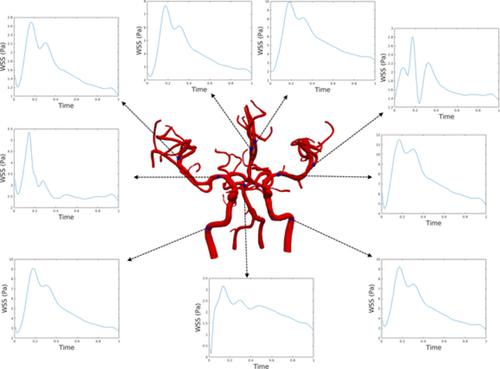当前位置:
X-MOL 学术
›
Int. J. Numer. Method. Biomed. Eng.
›
论文详情
Our official English website, www.x-mol.net, welcomes your
feedback! (Note: you will need to create a separate account there.)
A parallel non-nested two-level domain decomposition method for simulating blood flows in cerebral artery of stroke patient.
International Journal for Numerical Methods in Biomedical Engineering ( IF 2.2 ) Pub Date : 2020-08-11 , DOI: 10.1002/cnm.3392 Rongliang Chen 1, 2 , Bokai Wu 1 , Zaiheng Cheng 1 , Wen-Shin Shiu 1 , Jia Liu 1 , Liping Liu 3 , Yongjun Wang 3 , Xinhong Wang 4 , Xiao-Chuan Cai 5
International Journal for Numerical Methods in Biomedical Engineering ( IF 2.2 ) Pub Date : 2020-08-11 , DOI: 10.1002/cnm.3392 Rongliang Chen 1, 2 , Bokai Wu 1 , Zaiheng Cheng 1 , Wen-Shin Shiu 1 , Jia Liu 1 , Liping Liu 3 , Yongjun Wang 3 , Xinhong Wang 4 , Xiao-Chuan Cai 5
Affiliation

|
Numerical simulation of blood flows in patient‐specific arteries can be useful for the understanding of vascular diseases, as well as for surgery planning. In this paper, we simulate blood flows in the full cerebral artery of stroke patients. To accurately resolve the flow in this rather complex geometry with stenosis is challenging and it is also important to obtain the results in a short amount of computing time so that the simulation can be used in pre‐ and/or post‐surgery planning. For this purpose, we introduce a highly scalable, parallel non‐nested two‐level domain decomposition method for the three‐dimensional unsteady incompressible Navier‐Stokes equations with an impedance outlet boundary condition. The problem is discretized with a stabilized finite element method on unstructured meshes in space and a fully implicit method in time, and the large nonlinear systems are solved by a preconditioned parallel Newton‐Krylov method with a two‐level Schwarz method. The key component of the method is a non‐nested coarse problem solved using a subset of processor cores and its solution is interpolated to the fine space using radial basis functions. To validate and verify the proposed algorithm and its highly parallel implementation, we consider a case with available clinical data and show that the computed result matches with the measured data. Further numerical experiments indicate that the proposed method works well for realistic geometry and parameters of a full size cerebral artery of an adult stroke patient on a supercomputers with thousands of processor cores.
中文翻译:

一种模拟脑卒中患者脑动脉血流的并行非嵌套二级域分解方法[J].
患者特定动脉中血流的数值模拟有助于了解血管疾病以及手术计划。在本文中,我们模拟了中风患者全脑动脉的血流。在这种相当复杂的几何形状中准确地解决狭窄的流动具有挑战性,并且在短时间内获得结果也很重要,以便模拟可用于术前和/或术后计划。为此,我们为具有阻抗出口边界条件的三维非定常不可压缩 Navier-Stokes 方程引入了一种高度可扩展的并行非嵌套两级域分解方法。该问题使用空间非结构化网格上的稳定有限元方法和时间上的完全隐式方法进行离散化,大型非线性系统通过带有两级 Schwarz 方法的预处理并行 Newton-Krylov 方法求解。该方法的关键组成部分是使用处理器内核子集解决的非嵌套粗问题,其解决方案使用径向基函数插值到精细空间。为了验证和验证所提出的算法及其高度并行的实现,我们考虑了一个具有可用临床数据的案例,并表明计算结果与测量数据匹配。进一步的数值实验表明,所提出的方法在具有数千个处理器内核的超级计算机上适用于成人中风患者全尺寸脑动脉的真实几何形状和参数。该方法的关键组成部分是使用处理器内核子集解决的非嵌套粗问题,其解决方案使用径向基函数插入到精细空间中。为了验证和验证所提出的算法及其高度并行的实现,我们考虑了一个具有可用临床数据的案例,并表明计算结果与测量数据匹配。进一步的数值实验表明,所提出的方法在具有数千个处理器内核的超级计算机上适用于成人中风患者全尺寸脑动脉的真实几何形状和参数。该方法的关键组成部分是使用处理器内核子集解决的非嵌套粗问题,其解决方案使用径向基函数插值到精细空间。为了验证和验证所提出的算法及其高度并行的实现,我们考虑了一个具有可用临床数据的案例,并表明计算结果与测量数据匹配。进一步的数值实验表明,所提出的方法在具有数千个处理器内核的超级计算机上适用于成人中风患者全尺寸脑动脉的真实几何形状和参数。为了验证和验证所提出的算法及其高度并行的实现,我们考虑了一个具有可用临床数据的案例,并表明计算结果与测量数据匹配。进一步的数值实验表明,所提出的方法在具有数千个处理器内核的超级计算机上适用于成人中风患者全尺寸脑动脉的真实几何形状和参数。为了验证和验证所提出的算法及其高度并行的实现,我们考虑了一个具有可用临床数据的案例,并表明计算结果与测量数据匹配。进一步的数值实验表明,所提出的方法对于具有数千个处理器内核的超级计算机上的成人中风患者的全尺寸脑动脉的真实几何形状和参数非常有效。
更新日期:2020-08-11
中文翻译:

一种模拟脑卒中患者脑动脉血流的并行非嵌套二级域分解方法[J].
患者特定动脉中血流的数值模拟有助于了解血管疾病以及手术计划。在本文中,我们模拟了中风患者全脑动脉的血流。在这种相当复杂的几何形状中准确地解决狭窄的流动具有挑战性,并且在短时间内获得结果也很重要,以便模拟可用于术前和/或术后计划。为此,我们为具有阻抗出口边界条件的三维非定常不可压缩 Navier-Stokes 方程引入了一种高度可扩展的并行非嵌套两级域分解方法。该问题使用空间非结构化网格上的稳定有限元方法和时间上的完全隐式方法进行离散化,大型非线性系统通过带有两级 Schwarz 方法的预处理并行 Newton-Krylov 方法求解。该方法的关键组成部分是使用处理器内核子集解决的非嵌套粗问题,其解决方案使用径向基函数插值到精细空间。为了验证和验证所提出的算法及其高度并行的实现,我们考虑了一个具有可用临床数据的案例,并表明计算结果与测量数据匹配。进一步的数值实验表明,所提出的方法在具有数千个处理器内核的超级计算机上适用于成人中风患者全尺寸脑动脉的真实几何形状和参数。该方法的关键组成部分是使用处理器内核子集解决的非嵌套粗问题,其解决方案使用径向基函数插入到精细空间中。为了验证和验证所提出的算法及其高度并行的实现,我们考虑了一个具有可用临床数据的案例,并表明计算结果与测量数据匹配。进一步的数值实验表明,所提出的方法在具有数千个处理器内核的超级计算机上适用于成人中风患者全尺寸脑动脉的真实几何形状和参数。该方法的关键组成部分是使用处理器内核子集解决的非嵌套粗问题,其解决方案使用径向基函数插值到精细空间。为了验证和验证所提出的算法及其高度并行的实现,我们考虑了一个具有可用临床数据的案例,并表明计算结果与测量数据匹配。进一步的数值实验表明,所提出的方法在具有数千个处理器内核的超级计算机上适用于成人中风患者全尺寸脑动脉的真实几何形状和参数。为了验证和验证所提出的算法及其高度并行的实现,我们考虑了一个具有可用临床数据的案例,并表明计算结果与测量数据匹配。进一步的数值实验表明,所提出的方法在具有数千个处理器内核的超级计算机上适用于成人中风患者全尺寸脑动脉的真实几何形状和参数。为了验证和验证所提出的算法及其高度并行的实现,我们考虑了一个具有可用临床数据的案例,并表明计算结果与测量数据匹配。进一步的数值实验表明,所提出的方法对于具有数千个处理器内核的超级计算机上的成人中风患者的全尺寸脑动脉的真实几何形状和参数非常有效。











































 京公网安备 11010802027423号
京公网安备 11010802027423号